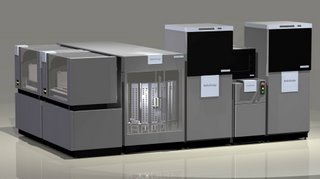Robot Works on AIDS Vaccine
A new lab robot called CrystalMation promises to speed up the discovery of new vaccines for HIV and other diseases.
The robot was developed by the RoboDesign division of privately held Rigaku.
Located at Scripps Research Institute, the $2.2 million Crystalmation, can complete in days a task that had previously taken months to perform.

From Scripps:
X-ray crystallography is a technique that can solve structures to exquisitely high resolution. To make the technique work, scientists manipulate a protein or some other molecule so that a crystal forms. This crystal is then placed in front of a beam of x-rays, which diffract when they strike the atoms in the crystal. Based on the pattern of diffraction, scientists can reconstruct the shape of the original molecule.
The catch is that it can be extremely difficult to get a crystal to form. In the past, scientists have spent months trying to coax a protein to form crystals by varying dozens of conditions and combinations of conditions, such as temperature, ionic strength, protein concentration, buffer, and pH—time spent with no guarantee of success.

Robotic crystallography brings the technique to a new level. Instead of varying conditions one by one, scientists can run dozens of conditions at once to see if any work.
In fact, the new system at Scripps Research is so automated and integrated that scientists can put a sample of protein in at one end, and, if all goes well, some two weeks later pick up high quality crystals to solve the structure. The machine handles the dispensing, sealing, incubation, and imaging without any human intervention.
This robotic technology helps to solve between 100 and 200 structures a year — about one every three working days.
This is a good example of robot technology that can extend capabilities to levels that are not possible without the robot help.
TSRI - News & Views
Wilson Lab
International AIDS Vaccine Initiative
Joint Ceneter for Structural Genomics
The robot was developed by the RoboDesign division of privately held Rigaku.
Located at Scripps Research Institute, the $2.2 million Crystalmation, can complete in days a task that had previously taken months to perform.

From Scripps:
X-ray crystallography is a technique that can solve structures to exquisitely high resolution. To make the technique work, scientists manipulate a protein or some other molecule so that a crystal forms. This crystal is then placed in front of a beam of x-rays, which diffract when they strike the atoms in the crystal. Based on the pattern of diffraction, scientists can reconstruct the shape of the original molecule.
The catch is that it can be extremely difficult to get a crystal to form. In the past, scientists have spent months trying to coax a protein to form crystals by varying dozens of conditions and combinations of conditions, such as temperature, ionic strength, protein concentration, buffer, and pH—time spent with no guarantee of success.

Robotic crystallography brings the technique to a new level. Instead of varying conditions one by one, scientists can run dozens of conditions at once to see if any work.
In fact, the new system at Scripps Research is so automated and integrated that scientists can put a sample of protein in at one end, and, if all goes well, some two weeks later pick up high quality crystals to solve the structure. The machine handles the dispensing, sealing, incubation, and imaging without any human intervention.
This robotic technology helps to solve between 100 and 200 structures a year — about one every three working days.
This is a good example of robot technology that can extend capabilities to levels that are not possible without the robot help.
TSRI - News & Views
Wilson Lab
International AIDS Vaccine Initiative
Joint Ceneter for Structural Genomics

0 Comments:
Post a Comment
Subscribe to Post Comments [Atom]
<< Home